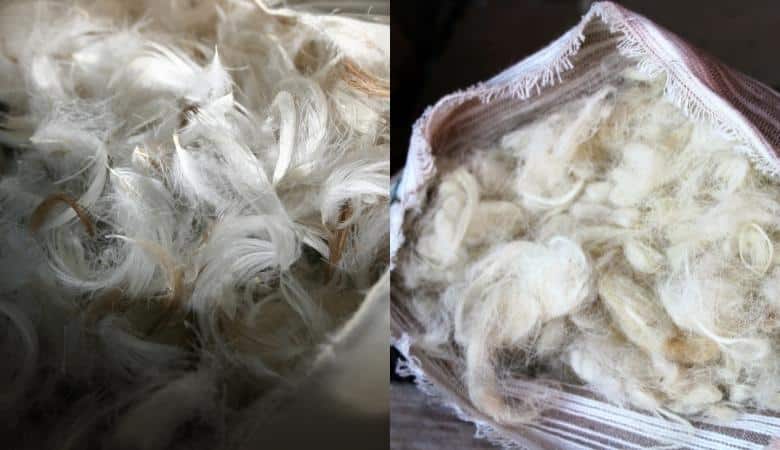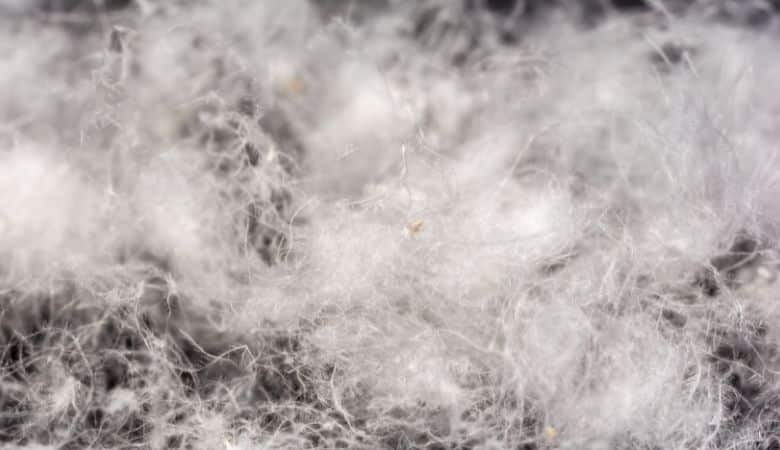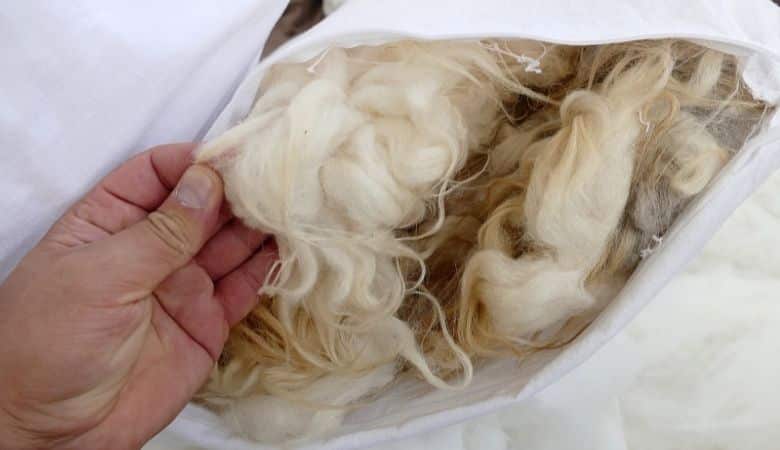This post is a part of the complete wool pillow buyers guide
Bedding material has come a long way, especially when it comes to pillows. Bedding manufacturers can perform wonders with synthetic fabric and filling. Yet, when it comes to pillows, stuffing like wool and down are still the most popular.
That should not be a surprise. When you think of the perfect pillow to relax with, you think of something soft and fluffy, right? Well, there aren’t too many fabrics softer than wool and down.
You may see some similarities when you look at these two types of pillows, but they are quite different. In fact, which one do you think is better? Let’s look at some similarities and differences between the two.

Similarities Between Wool and Down Pillows
- Both materials are 100% natural.
- Both materials are sometimes manufactured to be blended with other materials. Down can be composed of only white down or mixed with feathers. Most wool is from sheep, but some are from goats, alpacas, or other animals. Wool can be blended with other fibers, or it can stand alone as down can also.
- Both materials are soft and fluffy.
- Both materials come from animals.
- Both can be processed using natural, environmentally friendly methods.
- Both are effective at insulating the body.
Differences Between Wool and Down Pillows
- Down will keep you warm in the winter but not cool in the summer. Wool will keep you warm in the winter and cool in the summer.
- Down absorbs and retains odors, wool resists odors.
- Wool absorbs quickly, absorbing up to 30% of its weight in moisture, down does not.
- Wool is naturally temperature-regulating, down is not.
- Wool is fire-resistant, down is not.
Distinct Qualities of Wool and Down Pillows
All-Natural
Wool comes from sheep and is a 100% all-natural fiber; while down comes from birds. Both materials can be processed using natural, environmentally friendly methods.
While all natural, both materials can also be blended with other materials to produce products that are not 100% all-natural. Because they are all-natural, both fabrics promote breathability.

Feel
Both materials are soft and fluffy and feel good under your head. They both give you the feeling of a good relaxing, comfortable night of sleep.
Care
Gently treated, down pillows can be cleaned with soap and water, but under special precautions. If you don’t feel like you can take the time involved in caring for them as stated on the pillow label, opt to take them to the cleaners.
The best way to care for an organic wool pillow is to spot clean it with diluted vinegar and air dry the pillow outside in the sun or a window. They can also be fluffed in the dryer with tennis balls.
Moisture
Down traps moisture against your skin, making it harder to sleep coolly, while wool absorbs the wetness making it much easier to sleep.
Hypoallergenic
Down is not hypoallergenic and can be problematic for people who tend to become allergenic as they age. Wool is hypoallergenic and is a great option for anyone who suffers from allergies.
Durability
Both materials are durable and will last throughout their intended lifespan, with proper caring and cleaning.
Down Pillows: What They Are and Their Benefits

Down pillows come from birds. Down consists of the quill-less feather clusters of the chest and underbelly of geese and ducks. Baby birds have down first before they gain feathers.
Adult birds have down hidden under an exterior layer of tougher feathers. Down is extremely soft, like white dandelions or cotton balls. You’ll feel how amazingly soft and smooth they are.
Birds use down for insulation. The material traps air and allows it to insulate the birds to maintain a stable body temperature. Thus, these properties we find in down pillows can make us feel like we’re sleeping on a cloud.
That works fine for us in the cooler months, but in the warmer weather, it can be problematic for sleepers. Down can become overbearing, trapping moisture against your skin and making you far too warm and clammy.
That’s because when we sleep, we give off a pint of sweat a night. That perspiration has to go somewhere once it’s expelled from your skin. With down, that moisture traps against your skin, just as it does with the ducks.
Over time, as with most pillows, moisture and body oils cause the down to clump up, attracting mildew and causing the pillow to go flat. Because the moisture goes inside the pillow, the dampness eventually causes mildew.
It will also absorb and retain odors, and most possibly dust mites. Unfortunately, down is not hypoallergenic and can be problematic for people who tend to become allergenic as they age.
You can read more about down pillows and their benefits here.
Wool Pillows: What They Are and Their Benefits

Wool has been around for generations. We’ve heard the saying when we can’t go to sleep, “Count some sheep!” That’s because the soft, fluffy feeling you get from wool is associated with that of a sheep.
While it’s true wool does come from sheep, wool can also be blended with other fibers and come from animals like alpaca, angora rabbits, and camels.
One of wool’s greatest qualities is its ability to keep your body at a comfortable temperature while sleeping. Wool has moisture-wicking properties that can absorb up to 30% of its weight in moisture.
It absorbs quickly, keeping your face and hair dry while you sleep. Wool provides you with the warmth you need in the winter and the coolness you need when it’s hot.
Wool’s fibers are quite different from most other fillings, which gives it the edge it needs to not only regulate body temperature, it’s also resistant to fire; it can self-distinguish when removed from a fire. Wool is also very flexible and durable with the ability to be bent back more than 20,000 times without breaking.
Another great quality about a wool pillow is that it can be customized to your desired height and thickness. Wool pillows are designed so that you can easily add or remove filling to reach the perfect level of comfort for you.
You can read more about wool pillows and their benefits here.
Final Thoughts
While both pillows have great qualities, in the end it all depends on what you’re looking for in a pillow. What works well for one sleeper may not necessarily work well for another.
Hopefully, the similarities and differences presented here will provide you with what you need to determine which pillow would be a better fit for you.
Wool Pillows: A Complete Buyers Guide – Parts:
1. Why Use a Wool Pillow? The Benefits & Drawbacks
2. Wool vs. Down Pillows: Similarities, Differences & Which to Choose
3. How Long Do Wool Pillows Last? This is The Replacement Time
4. Do Wool Pillows Sleep Hot or Cool? Or Both Depending on The Climate?
5. Why do Wool Pillows Get Lumpy? How to “Unlump” Them
6. How to Soften a Wool Pillow: Step by Step Guide
7. How to Wash And Dry a Wool Pillow: Step by Step Guide
8. Best Wool Pillows of 2022 – Complete Review
